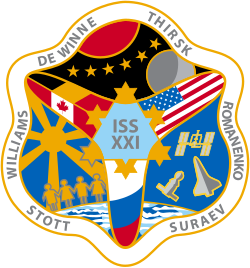 Promotional Poster | |
| Mission type | Long-duration expedition |
|---|---|
| Expedition | |
| Space station | International Space Station |
| Began | 11 October 2009 |
| Ended | 1 December 2009 |
| Arrived aboard | Soyuz TMA-15 Soyuz TMA-16 Stott: STS-128 Space Shuttle Discovery |
| Departed aboard | Soyuz TMA-15 Soyuz TMA-16 Stott: STS-129 Space Shuttle Atlantis |
| Crew | |
| Crew size | 6 (to November) 5 (from November) |
| Members | Expedition 20/21: Frank De Winne Roman Romanenko Robert Brent Thirsk Nicole P. Stott (to November) Expedition 21/22: Jeffrey N. Williams Maksim Surayev |
 Expedition 21 mission patch  from left to right: Maksim Surayev, Nicole Stott, Jeffrey Williams, Frank De Winne (commander), Robert Thirsk, Roman Romanenko | |

Expedition 21 was the 21st long-duration mission to the International Space Station (ISS). The expedition began on 11 October 2009, with Frank de Winne becoming the first ESA astronaut to command a space mission.
Contents
The handover between Expedition 20 and Expedition 21 required three Soyuz vehicles being docked to the station at the same time, the first time this has occurred.
Soyuz TMA-16 brought the final members of Expedition 21 to the ISS, along with space tourist Guy Laliberté. Laliberté returned to Earth on Soyuz TMA-14 with two members of Expedition 20 on 11 October 2009.
Nicole P. Stott was the last ISS expedition crew member to fly on the Space Shuttle. She returned to Earth aboard STS-129 in November 2009.
